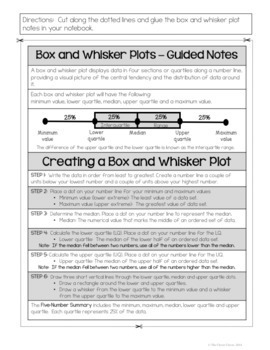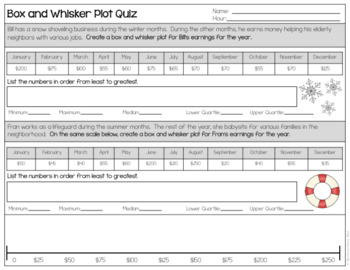Box and Whisker Plots: Notes, Worksheets and an Assessment
The Clever Clover
2.3k Followers
Grade Levels
6th - 9th, Homeschool
Subjects
Resource Type
Standards
CCSS6.SP.B.4
CCSS6.SP.B.5
CCSS7.SP.B.3
Formats Included
- PDF
Pages
6 + answer keys
The Clever Clover
2.3k Followers
What educators are saying
This was a great resource for use during our statistics lessons. Students found it helpful with understanding box and whisker plots.
Also included in
- Are your kids studying the measures of central tendency, box and whisker plots, stem and leaf plots, two-way tables, histograms and scatter plots? This valuable resource includes guided notes, worksheets, scavenger hunts, assessments and more that you can use for your statistics unit. Below you willPrice $20.80Original Price $26.00Save $5.20
Description
This resource includes detailed step by step notes on how to create a box and whisker plot, a worksheet and an assessment.
The notes include step by step instructions that can be referenced as students study box plots. Students can glue the notes directly into their notebooks. A box and whisker plot visual is used to display the four quartiles of data. As students complete each step, they will determine the five-number summary used to create a box and whisker plot. The guided notes address how to calculate the lower quartile and upper quartile if there is an even number of numbers. The interquartile range is also noted.
In addition to the notes, there is a guided practice problem that can be glued into the notebook as well. Students will explore the weights of twelve different cats to create a box and whisker plot. The practice problem has students explore an outlier and how that changes the look of the box and whisker plot.
There are two additional practice pages that can be used in a variety of ways. The three problems involving box and whisker plots include: the number of pets in a household, newborn baby weights and Olympic medals for swimmers and gymnasts. Students are asked to make conclusions about the two sets of data provided on Olympic medals.
Finally, there is a two page assessment on box and whisker plots. Students are asked to create two box and whisker plots on the same number line. Following this, there are nine questions about the box and whisker plots.
Answer keys are provided for all of the resources.
You may also be interested in the following free resource: Box and Whisker Plot - Freebie
Leaving feedback will earn you credits for future TPT resources. Follow me to receive discounts for the first 24 hours on new resources.
Please contact me if you have any questions. The Clever Clover
Connect with me on social media!
The Clever Clover - Pinterest
The Clever Clover - Instagram
The Clever Clover - Facebook
The notes include step by step instructions that can be referenced as students study box plots. Students can glue the notes directly into their notebooks. A box and whisker plot visual is used to display the four quartiles of data. As students complete each step, they will determine the five-number summary used to create a box and whisker plot. The guided notes address how to calculate the lower quartile and upper quartile if there is an even number of numbers. The interquartile range is also noted.
In addition to the notes, there is a guided practice problem that can be glued into the notebook as well. Students will explore the weights of twelve different cats to create a box and whisker plot. The practice problem has students explore an outlier and how that changes the look of the box and whisker plot.
There are two additional practice pages that can be used in a variety of ways. The three problems involving box and whisker plots include: the number of pets in a household, newborn baby weights and Olympic medals for swimmers and gymnasts. Students are asked to make conclusions about the two sets of data provided on Olympic medals.
Finally, there is a two page assessment on box and whisker plots. Students are asked to create two box and whisker plots on the same number line. Following this, there are nine questions about the box and whisker plots.
Answer keys are provided for all of the resources.
You may also be interested in the following free resource: Box and Whisker Plot - Freebie
Leaving feedback will earn you credits for future TPT resources. Follow me to receive discounts for the first 24 hours on new resources.
Please contact me if you have any questions. The Clever Clover
Connect with me on social media!
The Clever Clover - Pinterest
The Clever Clover - Instagram
The Clever Clover - Facebook
Total Pages
6 + answer keys
Answer Key
Included
Teaching Duration
2 hours
Report this resource to TPT
Reported resources will be reviewed by our team. Report this resource to let us know if this resource violates TPT’s content guidelines.
Standards
to see state-specific standards (only available in the US).
CCSS6.SP.B.4
Display numerical data in plots on a number line, including dot plots, histograms, and box plots.
CCSS6.SP.B.5
Summarize numerical data sets in relation to their context, such as by:
CCSS7.SP.B.3
Informally assess the degree of visual overlap of two numerical data distributions with similar variabilities, measuring the difference between the centers by expressing it as a multiple of a measure of variability. For example, the mean height of players on the basketball team is 10 cm greater than the mean height of players on the soccer team, about twice the variability (mean absolute deviation) on either team; on a dot plot, the separation between the two distributions of heights is noticeable.






